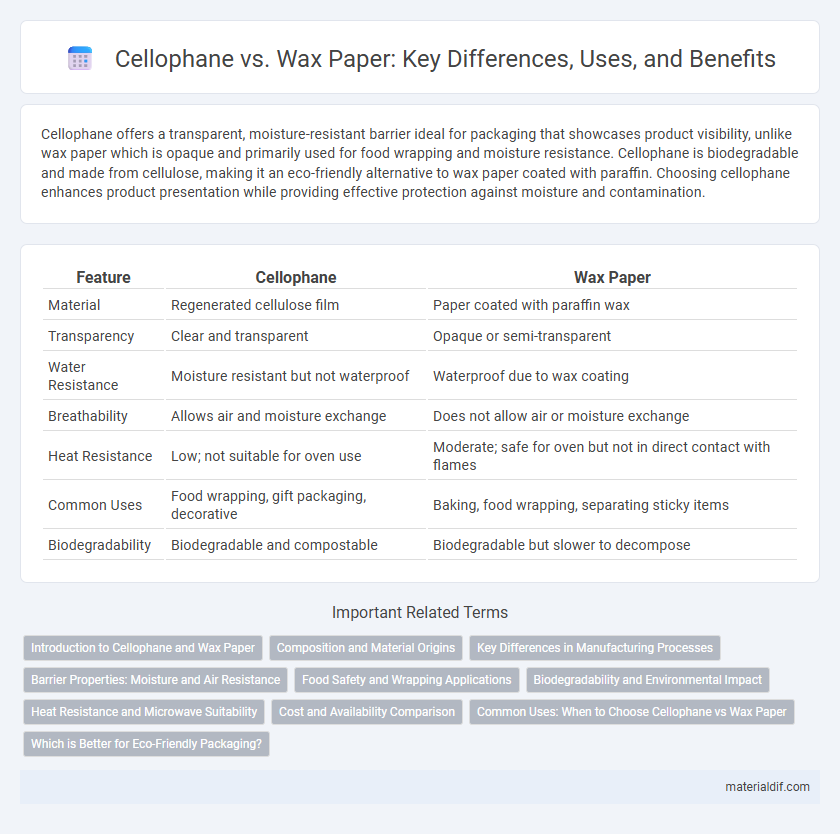Cellophane offers a transparent, moisture-resistant barrier ideal for packaging that showcases product visibility, unlike wax paper which is opaque and primarily used for food wrapping and moisture resistance. Cellophane is biodegradable and made from cellulose, making it an eco-friendly alternative to wax paper coated with paraffin. Choosing cellophane enhances product presentation while providing effective protection against moisture and contamination.
Table of Comparison
| Feature | Cellophane | Wax Paper |
|---|---|---|
| Material | Regenerated cellulose film | Paper coated with paraffin wax |
| Transparency | Clear and transparent | Opaque or semi-transparent |
| Water Resistance | Moisture resistant but not waterproof | Waterproof due to wax coating |
| Breathability | Allows air and moisture exchange | Does not allow air or moisture exchange |
| Heat Resistance | Low; not suitable for oven use | Moderate; safe for oven but not in direct contact with flames |
| Common Uses | Food wrapping, gift packaging, decorative | Baking, food wrapping, separating sticky items |
| Biodegradability | Biodegradable and compostable | Biodegradable but slower to decompose |
Introduction to Cellophane and Wax Paper
Cellophane is a transparent, thin film made from regenerated cellulose, known for its moisture-resistant and breathable properties, commonly used in food packaging to maintain freshness. Wax paper is coated with a thin layer of paraffin wax, providing a non-stick surface ideal for wrapping food and lining baking trays, but it lacks the breathability and transparency of cellophane. While cellophane offers a clear view of contents and better moisture resistance, wax paper is preferred for heat protection and preventing food from sticking during preparation.
Composition and Material Origins
Cellophane is made from regenerated cellulose derived from wood pulp or cotton fibers, resulting in a transparent, biodegradable film. Wax paper consists of paper coated with paraffin wax, which is a petroleum-based product, giving it a water-resistant but less breathable surface. The natural origin of cellophane's cellulose contrasts with the synthetic wax coating of wax paper, affecting their environmental impact and usability in food storage.
Key Differences in Manufacturing Processes
Cellophane is produced through the regeneration of cellulose dissolved in a chemical solution, followed by stretching and coating to create a transparent, biodegradable film. Wax paper, in contrast, is made by impregnating paper with paraffin wax or soybean wax, which provides moisture resistance but lacks transparency and biodegradability. The key difference lies in cellophane's cellulose base offering breathability and environmental benefits, while wax paper's manufacturing focuses on moisture barrier properties via wax coating.
Barrier Properties: Moisture and Air Resistance
Cellophane offers superior moisture resistance compared to wax paper due to its dense cellulose film structure, making it highly effective in preventing water vapor transmission. Wax paper, coated with paraffin wax, provides a modest barrier to air but is less effective than cellophane in maintaining airtight conditions. This distinction in barrier properties positions cellophane as the preferred choice for applications requiring enhanced preservation of freshness and moisture control.
Food Safety and Wrapping Applications
Cellophane is a biodegradable cellulose film that offers superior breathability and moisture resistance compared to wax paper, making it ideal for wrapping fresh produce and baked goods while maintaining food safety by preventing bacterial growth. Wax paper, coated with paraffin, provides water resistance but lacks breathability, which can trap moisture and promote mold development. For food wrapping applications, cellophane ensures longer freshness and safer preservation, especially for items requiring ventilation.
Biodegradability and Environmental Impact
Cellophane, made from cellulose derived from wood pulp, is biodegradable and compostable, breaking down naturally without leaving harmful residues. Wax paper, coated with paraffin wax often sourced from petroleum, is less biodegradable and can persist longer in the environment. Choosing cellophane over wax paper reduces plastic pollution and supports eco-friendly waste management practices.
Heat Resistance and Microwave Suitability
Cellophane is less heat resistant than wax paper, which can withstand higher temperatures without melting or burning. Wax paper contains a thin coating of wax that acts as a heat barrier, making it more suitable for microwave use where direct heat exposure occurs. In contrast, cellophane tends to melt or become brittle under microwave heat, limiting its suitability for cooking or reheating food.
Cost and Availability Comparison
Cellophane is generally more expensive than wax paper due to its biodegradable nature and production process using cellulose. Wax paper tends to be more widely available and cost-effective, making it a preferred choice for everyday kitchen use. Despite higher costs, cellophane's eco-friendly benefits justify its price in packaging applications requiring transparency and moisture resistance.
Common Uses: When to Choose Cellophane vs Wax Paper
Cellophane is ideal for wrapping fresh produce, candies, and floral arrangements due to its moisture resistance and transparency, allowing visibility while maintaining freshness. Wax paper works best for food preparation tasks like rolling out dough or wrapping snacks that don't require airtight seals, as its wax coating provides a non-stick surface but is not moisture-proof. Choose cellophane for presentation and preservation needs, while wax paper suits non-stick applications in the kitchen.
Which is Better for Eco-Friendly Packaging?
Cellophane is a biodegradable film made from cellulose, making it a more eco-friendly option than wax paper, which is coated with paraffin derived from petroleum. While wax paper is moisture-resistant, it is less environmentally sustainable due to its synthetic coating and lower compostability. Cellophane offers a renewable, compostable alternative that reduces plastic waste and supports sustainable packaging practices.
Cellophane vs Wax Paper Infographic

 materialdif.com
materialdif.com